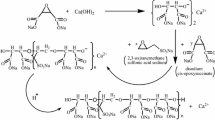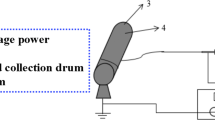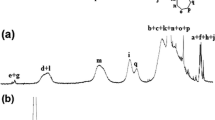Abstract
Poly[(disodium methylene malonate)-co-(vinyl alcohol)] [P(DSMM-VA)] and poly[(disodium ethoxymethylene malonate)-co-(vinyl alcohol)] [P(DSEMM-VA)] containing a poly(vinyl alcohol) (PVA) block as a biodegradable segment were prepared and their biodegradability and functionality were evaluated and compared with those of the corresponding fumarate and maleate copolymers. It was found that the 1,1-dicarboxylate-type copolymers, P(DSMM-VA) and P(DSEMM-VA), showed better biodegradability than the corresponding 1,2-dicarboxylate-type copolymers, P(DSF-VA) and P(DSM-VA). This improved biodegradability of P(DSMM-VA) and P(DSEMM-VA) is probably attributable to their more expanded polymer chain in aqueous solution, which will be more accessible to the degrading enzymes. The minimum chain length of the PVA-block, which acts as a biodegradable segment in the polymer chain, is estimated to be 2–3 and 3–4 monomer units for P(DSMM-VA) and P(DSEMM-VA), respectively. On the other hand, the minimum PVA block is about 5 and 7 monomer units for the fumarate and maleate copolymers, respectively. It was confirmed that P(DSMM-VA) showed excellent builder performance compared to the corresponding fumarate copolymer.
Similar content being viewed by others
References
S. Matsumura and S. Yoshikawa (1990) in J. E. Glass and G. Swift (Eds.),Agricultural and Synthetic Polymers, Biodegradability and Utilization, ACS Symposium Series 433, Am. Chem. Soc., Washington, DC, pp. 124–135.
S. Matsumura, S. Maeda, and S. Yoshikawa (1990)Makromol. Chem. 191 1269–1275.
S. Matsumura, M. Nishioka, and S. Yoshikawa (1991)Makromol. Chem. Rapid Commun. 12 89–94.
S. Matsumura, K. Amaya, and S. Yoshikawa (1992)J. Environ. Polym. Degrad. 1 23–29.
S. Matsumura, H. Shigeno, and T. Tanaka (1993)J. Am. Oil Chem. Soc. 70 659–665.
S. Matsumura, S. Maeda, J. Takahashi, and S. Yoshikawa (1988)Kobunshi Ronbunshu 45 317–324.
T. Suzuki, Y. Ichihara, M. Yamada, and K. Tonomura (1973)Agr. Biol. Chem. 37 747–756.
C. Sakazawa, M. Shimao, Y. Taniguchi, and N. Kato (1981)Appl. Environ. Microbiol. 41 261–267.
M. Shimao, H. Saimoto, N. Kato, and C. Sakazawa (1983)Appl. Environ. Microbiol. 46 605–610.
G. B. Bachman and H. A. Tanner (1939)J. Org. Chem. 4 493.
OECD (1981)OECD Guidelines for Testing of Chemicals, 301C, Modified MITI Test, Organization for Economic Cooperation and Development (OECD).
M. Shimao, H. Yamamoto, K. Ninomiya, K. Kato, O. Adachi, M. Ameyama, and C. Sakazawa (1984)Agr. Biol. Chem. 48 2873–2876.
S. Matsumura and H. Shimokobe (1992)Chem. Lett. 1859–1862.
S. Ito, S. Naito, and T. Unemoto (1988)J. Jpn. Oil Chem. Soc. 37 1006–1011.
OECD (1988)OECD Guidelines for Testing of Chemicals, 301D, Closed Bottle Test, Organization for Economic Cooperation and Development (OECD).
O. Okumura, T. Tokuyama, T. Sakatani, and Y. Tsuruta (1981)J. Jpn. Oil Chem. Soc. 30 432–441.
P. Kubelka (1931)Z. Tech. Phis. 12 539.
S. Matsumura and T. Tanaka (1993)Kobunshi Ronbunshu 50 761–766.
M. Finemann and S. D. Ross (1950)J. Polym. Sci. 5 259.
N. G. Kulkarni, N. Krishnamurti, P. C. Chatterjee, and M. A. Sivasamban (1970)Makromol. Chem. 139 165.
J. Brandrup and E. H. Immergut (1989)Polymer Handbook, 3rd ed., John Wiley & Sons, New York.
K. Ito and Y. Yamashita (1965)J. Polym. Sci. A3 2165.
J. Takeuchi (1989)Yosui to Haisui 31 294–305.
S. Matsumura (1993)J. Jpn. Oil Chem. Soc. 42 333–345.
E. A. Matzner, M. M. Crutchfield, R. P. Langguth, and R. D. Swisher (1973)Tenside 10 239–245.
M. M. Crutchfield (1978)J. Am. Oil Chem. Soc. 55 58–65.
Y. Abe, S. Matsumura, T. Miura, and K. Sakai (1981)J. Jpn. Oil Chem. Soc. 30 757–761.
Author information
Authors and Affiliations
Rights and permissions
About this article
Cite this article
Matsumura, S., Tanaka, T. Novel malonate-type copolymers containing vinyl alcohol blocks as biodegradable segments and their builder performance in detergent formulations. J Environ Polym Degr 2, 89–97 (1994). https://doi.org/10.1007/BF02074777
Issue Date:
DOI: https://doi.org/10.1007/BF02074777




